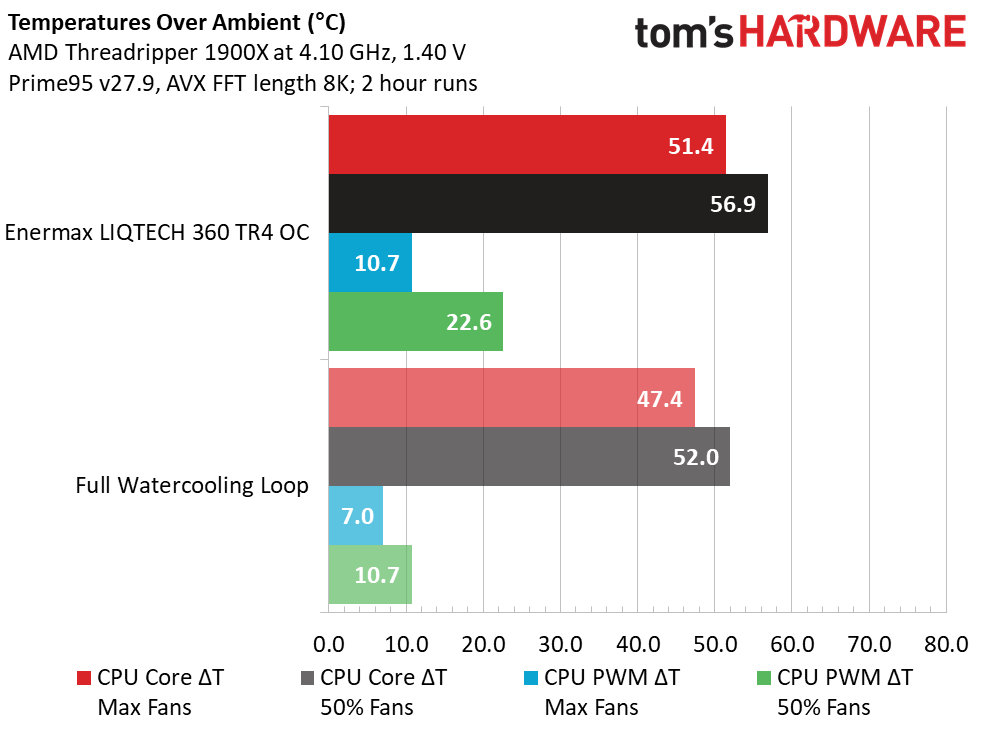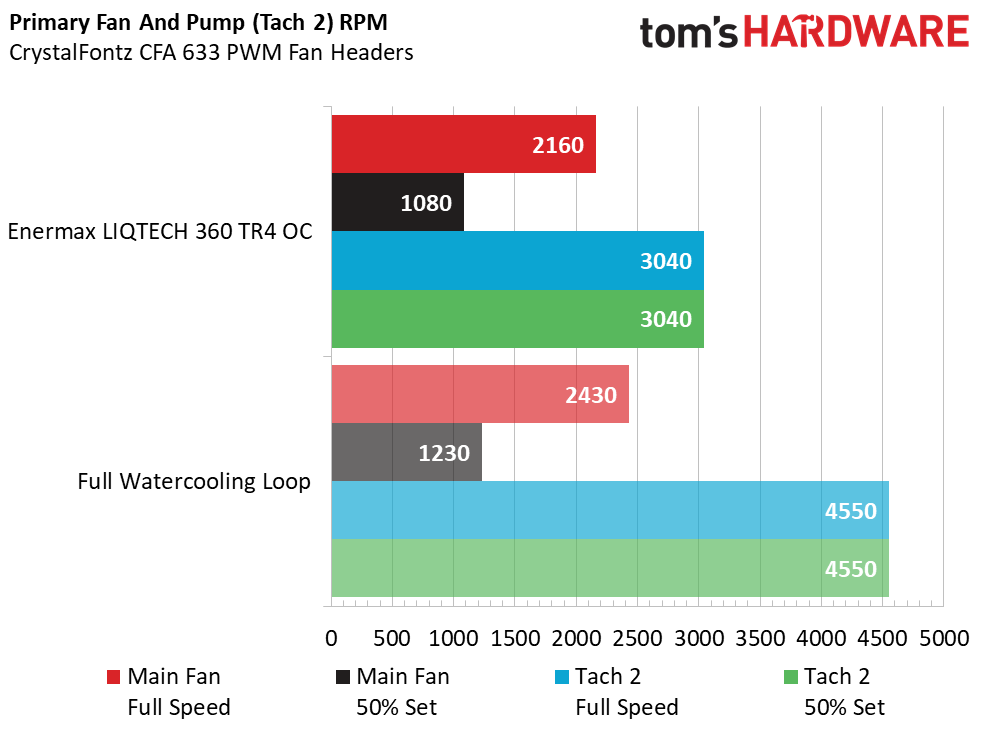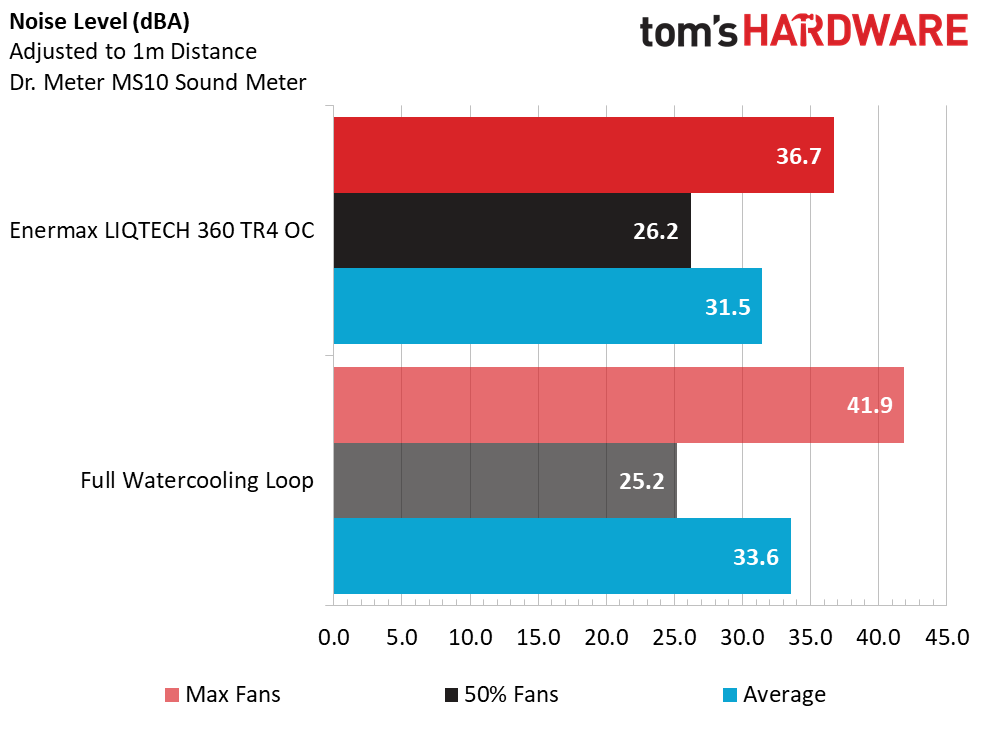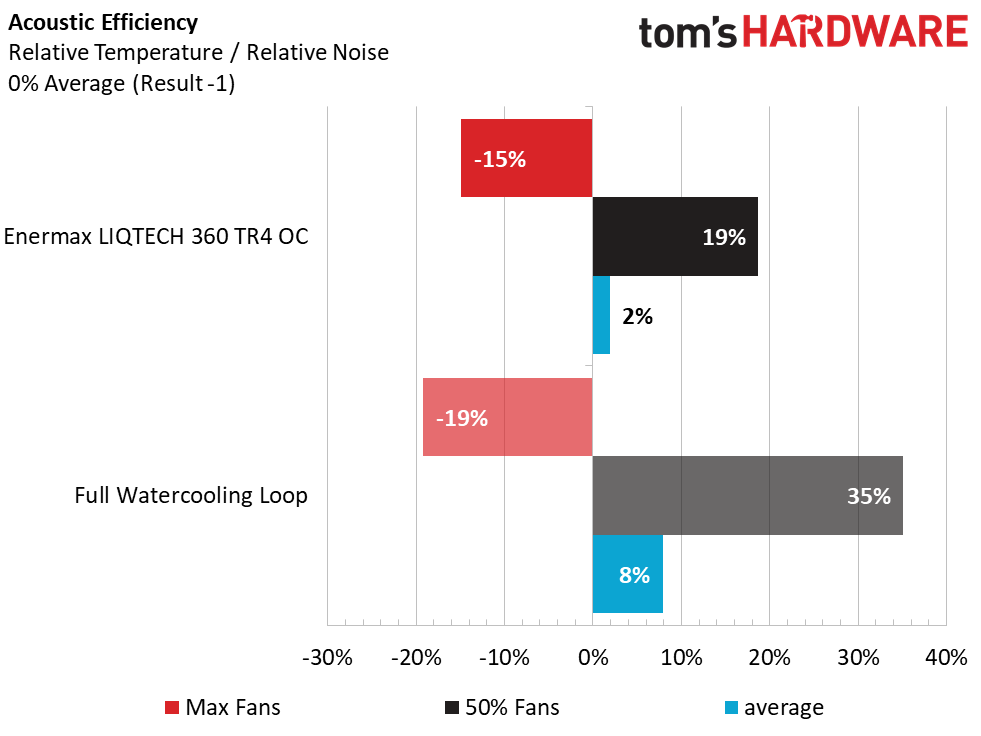Enermax Liqtech 360 OC TR4 Review: Taming Threadripper
Why you can trust Tom's Hardware
Testing Results & Conclusion
Here at Tom’s Hardware, we always like to compare hardware using our standard testing platform to provide results for each cooler based on identical testing conditions. Since this is our first Threadripper-specific cooler testing, we are comparing it against our in-house, full liquid-cooling loop composed of a Swiftech MCP50x pump, a Swiftech Apogee SKF Heirloom TR4 CPU block, a Swiftech MCP35x/MCP50x reservoir, Bitspower compression fittings, an XSPC EX360 radiator, and three Scythe Ultra Kaze 3000 RPM fans. Our AMD Ryzen Threadripper 1900X processor is clocked at 4.1GHz at 1.40V on an MSI X399 Gaming Pro Carbon/AC motherboard.
Going head to head with a full custom liquid-cooling loop is no easy competition for any cooler. However, our chart shows the Enermax Liqtech 360 TR4 OC turning in impressive load testing numbers just a few degrees Celsius over our custom benchmark cooling loop. Even our motherboard voltage regulators and power phase system probes return temperatures reporting effective cooling, indicating that the Liqtech 360 is providing excellent airflow benefit for adjacent components.
All fans will run at slower rotational speeds when being tasked to force large volumes of air through restrictive radiator fins, and the Enermax Twister Bearing Pressure fans are no different. They registered an average of 2160 RPM at full speed and 1080 RPM at 50% in our lab test scenarios, while the Liqtech pump remained at maximum speed, 3040 RPM, for the duration of all testing.
With three cooling fans spinning faster than 2100 RPM, we were surprised at the relatively low registered noise levels produced by the Enermax Liqtech 360. At 50%, the entire cooler is almost inaudible, even with the pump operating at 100% of its flow and pressure rate. (The cooling fans of the reference liquid-cooling loop are the notoriously loud Scythe Ultra Kaze 3000. While they move a lot of air, they also disturb the surrounding air much more in doing so.)
With load temperatures and noise held well in check, it should come as no surprise that the Acoustic Efficiency chart looks as favorable as it does. Granted, neither cooling solution posted a positive reading at its maximum fan speeds, but know that the graph bases all results against both full-speed and half-speed overall averages, including averages of both coolers at 50% fan RPM. With both cooling solutions turning in very quiet half-fan-speed readings, the Liqtech 360 TR4 OC was only 4 decibels off of the overall median value, showing the narrow acoustic margin at work here.
If you’re like us, this chart above is the one you have been anxious to see. With recent reductions in price, the Enermax Liqtech 360 TR4 OC was selling for around $135 at this writing, down from an original cost of $150. By comparison, the cost of our full liquid-cooling loop tallies up to $404. This means that for about a third of the cost of our reference liquid-cooling loop, you can maintain an overclocked eight-core AMD Threadripper 1900X using the Liqtech 360, and do so within 4 degrees Celsius.
In the Liqtech 360 TR4 OC, Enermax has graced the Threadripper world with a cooler that covers these large enthusiast processors in full, providing performance similar to custom liquid cooling with the easy installation and moderate cost of an AIO cooler. Enermax also keeps costs down by avoiding RGB lighting and the relevant software integrations. The lack of lighting might turn away some buyers who prefer millions of colors and a software UI. However, Threadripper fans seeking excellent cooling performance, and who wish to set up some simple fan-cooling curves, will find just that in the Liqtech 360 TR4 OC.
Get Tom's Hardware's best news and in-depth reviews, straight to your inbox.
MORE: Best CPU Cooling
MORE: How To Choose A CPU Cooler
MORE: All Cooling Content

Garrett Carver is a contributor for Tom’s Hardware, primarily covering thermal compound comparisons and CPU cooling reviews; both air and liquid, including multiple variations of each.
-
dudmont I've run an enermax Liqtech cooler. No complaints about it. I was impressed by the fans that came with it. They're not to be underestimated.Reply -
Giroro "As a single-socket design with a CPU larger than any consumer die to date"Reply
You mean the largest heat-spreader, not the die. The dies inside of threadripper are the same 192 mm as the rest of Ryzen/Epyc - in a 4 die configuration where only 2 of the 4 dies are functional. -
peaceones What a poor review by THW with only the lowest end Threadripper for testing..Reply
Fortunately though I have 2 1950x configured with this 360mm AIO and the other a 240mm. The 360 runs at around 48C on full load and 240 at 51C. Thermal paste application has alot to do with TR4 temps and it looks like writer only put the standard grain rice amount. Check on youtube for the termal paste benchmarks -
Doctor Rob I also have one and it works great. THOUGH I WISH they had temp probs and other built into it like my other setup does.Reply -
rubix_1011 Reply20911364 said:What a poor review by THW with only the lowest end Threadripper for testing..
Fortunately though I have 2 1950x configured with this 360mm AIO and the other a 240mm. The 360 runs at around 48C on full load and 240 at 51C. Thermal paste application has alot to do with TR4 temps and it looks like writer only put the standard grain rice amount. Check on youtube for the termal paste benchmarks
An 'X' with small dots between is how paste was applied, although I'm not certain how 'grain of rice' was deduced without seeing the application since I don't recall writing about the TIM amount in detail.
It is great to see others having success with this cooler, also. -
jdball What's the difference between CPU Core and CPU PWM in the Temperatures over ambient graph? Also, does the temperature in the graphs exclude the ambient temperature e.g. if the ambient temperature is 25 degrees C then 51.4 is actually 76.4 degrees C?Reply -
rubix_1011 Temperature over ambient accounts for ambient room temperature, so yes, the display shows the difference.Reply
CPU core is reported core temperatures; PWM represents the motherboard's power delivery and voltage regulators which are cooled by the factory motherboard heatsink.




